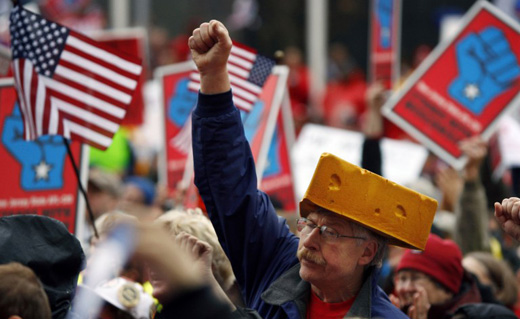
Senator Bernie Sanders’ campaign gave itself a shot in the arm by trouncing Secretary Hillary Clinton in the three most recently held caucuses on March 26 (Alaska, Hawaii, and Washington state). Even with these victories, though, the upcoming Wisconsin primary could be a make-or-break moment for his campaign.
On the ground, the contest between the two candidates remains tight. If one discounts the “superdelegates” – party leaders, governors, senators, representatives and Democratic National Committee members who are unpledged and free to support any candidate – the race for the Democratic Party nomination is much closer than most pundits had predicted.
As of this writing, Clinton has 1,243 pledged delegates (56 percent) to Sanders’ 980 (44 percent). Since Clinton has been in the national news media since 1991 or so (starting with Bill Clinton’s campaign for the White House), and since Sanders is a self-described “democratic socialist,” the tightness of the race is more stunning than the numbers show.
An often-heard criticism has been that Sanders has won these delegates nearly only via caucuses; Clinton, on the other hand, has won most of her delegates through the primaries. The assumption in this argument is that primaries are more democratic than are caucuses.
But is this criticism factually true?
Clinton has decisively won 13 primaries to Sanders’ four, with two very close triumphs (a margin of two percent or less) by Clinton in Illinois and Massachusetts, one by Sanders in Michigan, and one virtual tie in Missouri. In the caucus states, Clinton has won two contests to Sanders’ 10, and there was a virtual tie in Iowa.
So, indeed, the general claim that Clinton is winning the primaries and Sanders is winning the caucuses is factually accurate. However, the assumptions behind the criticism should be examined closely. And since millions are now thinking about and voting in elections, what better time is there to scrutinize our nomination system?
A history of elite picks
Prior to the 1830s, members of Congress met in party caucuses (the “King Caucus” system) to choose their respective presidential nominees. In the 1824 election, the caucus nominee, William Crawford, carried fewer states than did three other candidates of his Democratic-Republican Party: John Quincy Adams, Henry Clay, and Andrew Jackson.
This method changed first with the Anti-Masonic Party convention in 1831. The following year, the Democratic Party held its first convention, and seven years later, so did the Whig Party. Generally speaking, state caucuses selected party insider delegates to the national conventions, which then elected the presidential nominees.
The Progressive Movement of the early 1900s pushed for primary elections in order to increase popular participation and decrease the influence of leaders and party machines. These first presidential primaries were held in 1912, though turnouts were low and results were often ignored. By 1916 more than half of all states held primary elections.
However, party leadership sensed the real potential that these elections held for undermining their preferences. Additionally, at a time when there was very little government, the primaries were very expensive for parties to put on. Besides, with Black and other minority voters excluded from what were effectively “whites-only primaries” in many southern states, the results were distorted anyway. By the 1930s, many states had repealed their primary laws.
Indeed, even into the 1950s, primaries did not determine nominees. Illinois Governor Adlai E. Stevenson, for instance, did not enter even one of the 16 primary elections held in 1952, yet still emerged as the Democratic candidate.
Since nominees had to curry favor with the party leadership, why would candidates bother to spend time and money on inconsequential primaries? Many state primaries only listed the names of the delegates on the ballot but not of the candidates whom these delegates favored. Most of them had zero bearing on the distribution of delegates at state and national conventions.
Caucuses – which were attended by party insiders rather than the general population, were not well publicized, and were often held more than a year before the national convention – were all-important.
1968 and the push for democratization
The 1968 election, however, led to drastic changes. Over the issue of the war in Vietnam, President Lyndon Johnson did not seek re-election. In the Democratic primaries that year, Senators Eugene McCarthy and Robert Kennedy together won over two-thirds of the votes.
Johnson’s pro-war Vice President, Hubert Humphrey, entered the race too late for any of the primary elections, but he was the favorite of the party establishment. At the convention, he faced off against the more popular anti-war candidacies of McCarthy and Senator George McGovern of South Dakota, who had entered the race following Kennedy’s assassination. Ignoring the massive support given to anti-war candidates in the primaries, Humphrey was awarded the party’s nomination on the very first ballot at the convention.
Clearly, the voices of activists – inside and outside the convention – were not heard.
To deal with the backlash after Nixon’s defeat of Humphrey, the Democratic National Committee launched the McGovern-Fraser Commission to recommend new rules. It proposed that national convention delegates be selected in forums open to all party members; that these forums (primaries and caucuses) and state conventions be held within the calendar year of the presidential election; that national delegates be distributed proportionally according to voting results; and that the national party organization (not the states) have control over delegate certification.
These reforms did not seek to replace the domination of caucuses with primaries, but they did attempt to wrest control of the caucuses from party leaders and place it in the hands of the general membership. (The reforms have also had an effect, albeit less extensive, on the Republican Party. For example, many of their primaries are winner-take-all contests, and North Dakota GOP delegates are decided upon at a state convention instead of a primary or a caucus.)
Regardless of intent, the number of states holding primaries for the Democratic Party nomination has drastically increased over time. It went from 15 in 1968 to 21 by 1972, to a high of 40 in 2000, and now 38 this year (including Washington, D.C. and Democrats Abroad). Along with this increasing number of contests has come much wider popular participation.
Caucuses vs. primaries today
The Democratic Party leadership has concluded that nominees based on primary victories generally have broader appeal than (perhaps) better organized nominees whose strength has been the caucuses. Why? Because the base of victory is viewed as much broader.
However, caucuses were the ticket to President Obama’s nomination in 2008, when he won fewer primaries (19) than then-Senator Clinton (20), but managed to take 14 of the 17 caucuses – providing him the margin of victory. And his win in the Iowa caucuses proved decisive in pulling African-American support away from Clinton. Winning Iowa showed Black voters that he wasn’t just another Black protest candidate; many white voters were (finally) ready to vote for a Black candidate.
There are significant issues with the primaries, however. First, everyone in a given state, including members of the opposing parties, is required to foot the bill for the primary election. This, despite the fact that many of these people are not even eligible to vote.
Furthermore, “open” and “semi-closed” primaries and caucuses allow voters not registered with a particular party to vote in that party’s contest. Currently, the 24 closed states comprise less than half the nation. From this writer’s perspective, the nomination of a party’s candidate would ideally be an internal affair, not one subject to manipulation by non-members and paid for by everyone else.
The calendar, however, is the biggest issue. The general election doesn’t happen in one state or in groups of states at a time, so why should the primaries and caucuses for presidential candidates not be on the same date? To allow Iowa and New Hampshire – very unrepresentative of the entire nation – the ability to diminish the field of candidates seems very irrational.
At any rate, the upcoming Wisconsin primaries are pivotal for both parties. A Sanders victory keeps his shot at the Democratic nomination mathematically possible, and a Trump defeat keeps hope alive for the Stop Trump movement on the GOP side.
Again, though, why should moments like this be decided upon in only one out of 50 states?
Photo: Mel Evans/AP










